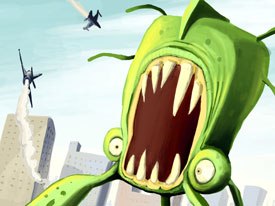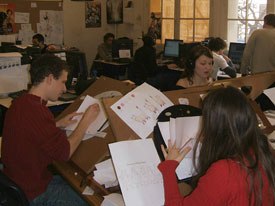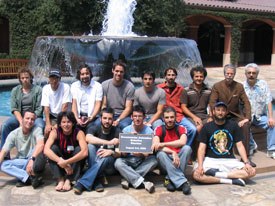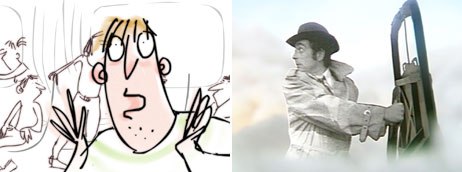Karen Raugust looks into European schools, offering the variety of programs focusing on 2D and 3D animation and visual effects.

City Monster by Soren Bent is an example of recent student work from Denmark’s The Animation Workshop. Courtesy of The Animation Workshop.
A number of educational institutions in Europe specialize in animation and/or visual effects. Each has a particular focus, its own areas of specialization and a unique impact on the animation industry, both in its own country and abroad. Here’s an update of the goings-on at a selection of leading animation institutions.
The Animation Workshop
Founded in 1989 and located in Viborg, Denmark, The Animation Workshop has five departments. The Character Animation Education department offers a bachelor’s degree in character animation, with the first two years focused on 2D and 3D principles and the third and fourth on production, internships and the completion of a graduation film. A maximum of 25 students are enrolled in each year, for a total of 100, in this department.
The Professional Training department offers courses developed by and for professionals, including 3D character animation and art, concept design and storyboarding, with about 50 students participating each year. The Drawing Academy has two intensive 22-week courses in drawing for about 75 students a year who want to work in graphic design, animation, advertising, architecture, communication or teaching. The fourth department, the Open Workshop, is an artist-in-residence and project development facility that allows about 20 participants per year to come together and develop animated film, TV, web and game productions. And the Center for Animation and Education offers classes for children.
The Animation Workshop’s Tim Leborgne says the school has developed two new courses recently, one focusing on modeling and 3D environments for 3D artists, and another on concept development. In the latter, students develop their own TV and film projects, supervised by industry experts. Both of these new courses are supported by the European Union’s MEDIA Programme.
Over the next two years, the school will introduce several additional programs, according to Leborgne. They include a bachelor’s degree in digital film design, debuting in fall 2007; accredited exchange semesters in classical drawing, 3D character animation and 3D art, starting in fall 2007, spring 2008 and fall 2008, respectively; a master course in animation production management, starting in spring 2008; and a master’s degree in concept development for television, film and interactive media, starting in fall 2008.

The Animation Workshop features five departments and will introduce several new programs over the next two years. Media by Andreas Gröntved courtesy of The Animation Workshop.
In addition, the school is working to develop a “hothouse,” or incubator, for young animation companies, and a film production fund for the Jutland, Denmark, region, which is where Viborg is located.
Leborgne stresses the close connections the school has with the animation industry. “All of our programs are developed in very close collaboration with recognized and active professionals from the animation industry, and our teaching modules and courses are taught only by short-term guest teachers who are also active professionals,” he says. “Thanks to this, the teachers cover the most relevant and recent techniques and methods and the students are constantly confronted with industry-level quality expectations.”
Graduates of The Animation Workshop have been placed at a number of studios around the world, including Folimage in France, Brown Bag Films in Ireland, Aardman in the U.K., Cartoon-Film in Germany, BRB in Spain, DreamWorks in the U.S and many more. “Our students leave ready to work immediately,” says Leborgne.
EMCA-EMCI
L’ecole des Métiers du Cinéma d’Animation et de la Création Infographique (EMCA-EMCI) is located in Angoulême, France. There are 36 students in EMCA, which is a two-year course focusing on 2D animation, and 16 in EMCI, a one-year program focusing on 3D. Some students complete only one or the other, but the entire three-year course covers both components, according to Christian Arnau, head of education at EMCA.
Students learn the entire animation process, from storyboard to layout to animation; the focus is finding a good balance between acquiring a strong technical base and developing individual creativity; as is the case with many schools, each student must complete their own film before graduation. The students also are challenged with technical exercises based on studio productions; many teachers in the courses are professionals who use real-life examples in the classwork.
Graduates find positions in studios around the world, including in Europe (England, Ireland, Spain and Switzerland) and Japan, as well as in France, mostly in Paris or at a number of creative companies located in the Charente region (where Angoulême is), collectively known as the Syndicat Magelis Pôle Image. Some become animation directors or writers, while others become Flash or 3D animators or compositors.

FAMUs belief that animation is one of the branches of the dramatic arts differentiates it from other Czech schools. Its courses emphasize artistic expression. The Light by David Sukup courtesy of FAMU.
FAMU
The Film and TV School of the Academy of Performing Arts in Prague (FAMU) offers two programs in classical hand-made animation, a three-year bachelors program and a five-year masters program. The first focuses on animation technique, while the second trains students to write and produce their own films, from scriptwriting through directing, animation and art. About five students are accepted per year.
According to FAMUs Jiri Kubicek, the school believes that animation is one of the branches of the dramatic arts, which differentiates it from other schools in Czechoslovakia that include animation within the school of fine arts. The courses, whether focusing on traditional or computer-generated animation, place an emphasis on artistic expression. Recent additions to the course catalog include several classes focusing on digital techniques.
Each student must create one or two short films each year, with a production crew consisting of students from the various departments (production, editing, sound, photography, etc.). Although most FAMU graduates tend to work locally, some have secured positions at studios in Germany, the U.K. and other countries, in a number of disciplines including live-action, special effects, fine arts and computer graphics, as well as animation.

Students determine their own study at the Filmakademie where animation, vfx and storytelling are emphasized. My Date from Hell by Tim Weimann and Tom Bracht courtesy of Filmakademie de Baden-Württemberg.
Filmakademie de Baden-Württemberg
At the Filmakademie, students determine their own focus of study rather than following a set curriculum, according to Thomas Haegele, head of the schools Institute of Animation, which encompasses animation and visual effects. The students create their own animated shorts, using a variety of techniques as they learn about the animation process. Emphasis is placed on storytelling how to develop believable characters, bring them to life and relate their story to the audience but free, artistic, visually associative works outside the storytelling tradition are equally accepted, Haegele says.
On the vfx side, students learn the vfx process by contributing vfx to feature films, commercials and documentaries created by students in those respective departments of the Filmakademie. Students also have opportunities to learn realtime and game animation, as well as storytelling, concept and design for all animation formats. There also are courses in research and development, where students learn to rig, work with expressions and scripts, program shaders, tools and plug-ins, and are exposed to other technical issues.
In all courses of study, emphasis is placed on independent and responsible work within a team, Haegele says. Almost all of the projects evolve as work in larger teams, often in collaboration with students from other departments. Each year, 10 to 15 students are accepted (from 100 to 150 applicants), with a few focusing on each discipline, whether character animation, visual effects, technical direction or other areas. Students can change concentrations as they wish, setting their own priorities. They also take courses in directing, script writing, camera and experimental filmmaking in other departments of the Filmakademie during their first two years.

Thomas Haegele and the Filmakadmie staff stress independent and responsible work within a team.
Two years ago, the Institute of Animation began offering a course in real-time applications, which focuses more on the cinematographic aspects of games particularly the convergence of games and film than on game development. Three years ago, it introduced a two-year, postgraduate technical director course, which is for computer science graduates who want to specialize in digital film production. The first graduates have been in demand throughout Europe and abroad, according to Haegele.
Several graduates of the Institute of Animation have created their own companies, including Unexpected and Studio Soi in Germany, while others work at studios all over the world, from Industrial Light & Magic and DreamWorks in the U.S., to Framestore and Aardman in Europe.
Courses are taught by international guest lecturers from the industry; there are no staff teachers. In addition to the professionals who teach on an ongoing basis, many guest lecturers visit campus for one to three days, speaking about their work and looking over student projects. Students also can participate in exchange programs with other schools and internships with studios during their tenure at the Filmakademie.
Student work is shown at fmx, the animation conference hosted by the Institute of Animation, as well as at film festivals around the world.

Gobélins focuses on both the fine art and technical aspects of animation production. Au bout du fil (At the end of the string) by Amandine Pecharman courtesy of Gobélins.
Gobélins
Gobélins, lecole de limage is a Paris-based school of visual communications operated by the Chamber of Commerce and Industry in that city. It offers basic and professional training in interactive multimedia and animation, as well as photography, graphic arts, industrial graphics and video.
The animation department was founded over 30 years ago, according to Eric Riewer, head of international relations. Like other schools, the curriculum focuses on both the fine art and technical aspects of animation production. Nearly 90% of the teaching is done by working professionals at studios and production companies. The school also hosts visiting artists, directors and producers from around the world.
The three-year program, to which 25 students between ages 18 and 26 are admitted each year (out of as many as 800 applicants), gives students experience in both traditional and digital techniques, while also nurturing their creative edge, Riewer says. We seek to train young artists who will help shape the future of animation in France and around the world. The third year of the program is devoted to 3D character animation and to teams making a short film using a variety of animation techniques.

Applicants must have a fine arts background to be accepted into Gobélins. Courtesy of Gobélins.
Riewer notes that the program changes with the industry, allowing students to learn new methods and technologies while building their classical animation skills, including acting, timing and observation. Students participate in internships at animation studios and production companies during school holidays.
Applicants must have a fine arts background to be accepted into Gobélins. We think we are more or less unique in requiring such strong drawing skills to get into the program, emphasizing 2D animation in the first two years to really get the foundations of character animation into their skillset, and then teaching 3D animation to the same high standard of professional level skills, Riewer says.
Aside from the three-year program, the school offers a professional training course in animation production management, in association with a French university, and short professional classes in Maya and 3ds Max. Gobélins also has exchange programs with the California Institute of the Arts and the Institute of Animation at the Filmakademie Baden-Württemberg.

Interaction between students and working professionals is important with most schools. Here, students from Gobélins visit DreamWorks in 2005. Three Gobélins alumni have since been hired at the animation studio.
While the focus of the program is on animation rather than visual effects, many students end up working for vfx studios such as Framestore in London. While Gobélins graduates work all around the world, 90% choose to remain in France and work on European projects, according to Riewer, who notes that grads work in almost every studio in Europe. Meanwhile, a core of 30 graduates have been with DreamWorks since its inception Eric Bergeron, co-director of The Road to El Dorado and A Shark Tale, is a graduate and at Amblin Ent. before that. A number worked at Disney when that company had a studio near Paris, and several work at Pixar.
Films by Gobélins students are used as curtain-raisers at all the official screenings of the Annecy International Animated Film Festival. The public can view the films online after the festival each year.
9Zeros
9Zeros, a four-year-old program in Spain, offers professional animation training to about 120 students. Disciplines include cartooning, 3D animation (Softimage XSI) and stop-motion. In fact, its 400-hour course in stop-motion production is a program that is unique in Europe, according to spokesperson Montse Sanjur. 9Zeros also trains in editing and image compositing programs such as Avid and Combustion 3. Recent additions to its course roster include an introduction to 3D Studio Max, among others.

Spains 9zeros school produced Caballos de Tiza (left) by Daniel Cánovas. The school seeks a balance between artistic and technical skills, and training students first as artists, and then technicians. Courtesy of 9zeros.
Sanjur says the school is looking for a balance between artistic and technical skills, but trains its students first as artists and, secondarily, as technicians. Most of its graduates end up working at Spanish studios, in positions ranging from modeling, to 3D animation and character design, to producing. 9Zeros has an employment exchange for all students who have finished their final course project. It also offers graduates the possibility of producing shorts from their final projects, which they can use to secure work in the future.
9Zeros has a credit-sharing agreement with the Politechnique University in Catalonia, which allows students to obtain degrees from both institutions.
La Poudrière
La Poudrière animation film school was launched in 1999 by Folimage animation studio in Valence, France. Its two-year program is unique in that it specializes in animated film directing, according to La Poudrières Annick Teninge. It is open to French and foreign students, as long as they have technical training or some experience in animation. Classes are small (nine to 10 students per class), and the teaching methodology focuses on a supervised project.
Students do exercises that train them in specs, layout, storyboarding, animatics, sound and editing, and also complete a short film that allows them to learn the film-making process from beginning to end and to be in charge of a film, including all of its technical and creative aspects. Students must work within a given budget and time schedule. Projects include personal and commissioned films, book adaptations and television series.
Three years ago, La Poudrière introduced an 11-week module on scriptwriting and childrens book adaptation. Run in partnership with a panel of childrens book publishers, the course allows students to create scripts, storyboards and animatics and to deal with the particular challenges of storyboarding, directing and editing a book-based project. Students develop a concept for a book-based TV series and write a script for a 13-minute TV special based on a book. In keeping with the schools focus on the practical, real-world aspects of animation, the students present their projects at the end of the course to a panel of childrens book publishers, scriptwriters, filmmakers and producers.

Frances La Poudrière is unique in that it does not have a teaching staff; courses are taught by guest teachers and lecturers, most whom are working professionals. Bouts En Train (left) and The End © La Poudrière
La Poudrière does not have a teaching staff; courses are taught by 60 to 80 guest teachers and lecturers per year, including filmmakers, scriptwriters, storyboard artists, animators, editors, producers, distributors and book publishers from around the world. The school also has partnerships with broadcasters, so students can work with them in creating commissioned works.
The school tries to gives its students a broad grounding in the arts outside of animation. Teninge says it takes its students to the movies at least once a week, and they get exposure to literature, theater and music as well. We believe, at least we hope, that multiplying cultural experiences will nurture their work as filmmakers, she says.
Because the school is small, it is able to stay in touch with its graduates and use them to help place new graduates in the industry. Most work in France or other European countries, primarily in the television industry as storyboarders, animators or assistant directors. Most continue to develop personal projects as well, some with development grants from the French Centre National du Cinéma or with support from producers or television networks.
Short films by La Poudrière students have won awards at Annecy, Zagreb, Hiroshima, Ottawa, Cartoon Forum and other film festivals.
Supinfocom
Supinfocom, which specializes in teaching the creation of digital content, was founded in 1988 by the Valenciennes Chamber of Commerce and Industry, and its original campus is located in Valenciennes in northern France. A second campus opened in 2000 in Arles, in southern France.
Programs include a two-year foundation course, which serves as a transition between secondary education and specialist studies in digital media. Classes in this program include fine and graphic arts topics such as sketching and typography, film analysis, introduction to animation, 2D computer graphics, Illustrator, Photoshop and AfterEffects, among others.

Supinfocom specializes in teaching the creation of digital content. Out Once Upon a Time (left) by Jérôme Dernoncourt, Samuel Deroubaix and Corentin Laplatte and 8848 by Grégory Jennings, Kévin Franczuk and Ma
The two-year higher-education course, which requires two years of higher education or professional experience to be admitted, includes courses on scriptwriting, 2D and 3D animation techniques and software, compositing and post-production, and other more advanced topics. In the final year, groups of three students produce a short film.
Supinfocom students are employed in studios in France and abroad, working in television, film, visual effects, videogames, rides and broadcast design. Each student must work at a studio during the summer during each year of study.
Karen Raugust is a Minneapolis-based freelance business writer specializing in animation, publishing, licensing and art. She is the author of The Licensing Business Handbook (EPM Communications).







